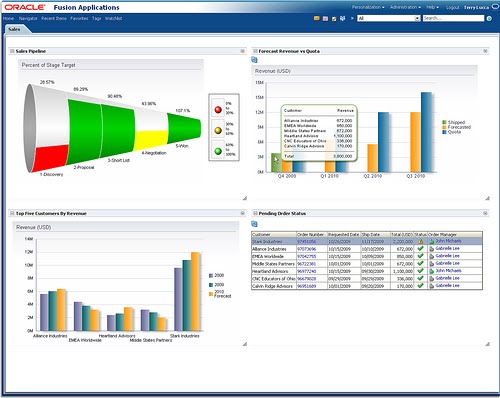Oracle Open World 2009 - It's a Wrap!
Well it's 7am on Friday morning and it'll soon be time to leave Open World and travel back to the UK. I've given myself the morning off to look around SF and get some presents for the family, as since I arrived on Saturday afternoon I've constantly been involved in session preparation, delivering sessions, meeting customers and colleagues at the stand and going to sessions. As with each year there are many things I'd have liked to have done but didn't get time to - Mogens' Oracle Closed World was something I particularly wanted to get to but couldn't - but overall it's been a great conference, and thanks to Justin, Lillian, Victoria and the rest of the OTN team for bringing me over.
The major theme of the last two days for me was Oracle Warehouse Builder and data integration in general. On Wednesday, Antonio Romero, David Allen and myself organized an "unconference" session in Moscone West where we did some impromptu demos of OWB11gR2 new functionality in an informal setting. I was pleased to see the room was full with OWB enthusiasts and customers, and here's part of a video that Claus Bille shot whilst we were speaking (there's more videos from Open World on Youtube here):
This was followed by a more lengthy session on the Thursday, where myself, Holger Friedrich and John Heaton from Iseerix went through more of the OWB11gR2 new features over an extended two-hour session at the nearby W Hotel. It's interesting seeing the reactions from people around new features such as code template mappings; there has been less initial take-up than I expected, though this is probably more down to OWB11gR2 only being available on Linux at the moment (i.e. no Windows client for the time being). I do wonder though whether OWB developers without an additional background in ODI will "get" the code templating system, or whether it'll be something like "experts" and "multiple configurations" that are rarely used or understood. Certainly to me this is a very powerful way to extend the capabilities of OWB and we'll be covering it and using it extensively on projects, but I wonder how easy it'll be for less experienced developers to use. We shall have to see.
Other than that, the big news on Wednesday was Larry's keynote. As the unconference session didn't finish until about ten past three there was no chance of getting a good seat in the main auditorium, and so we pulled up a seat in the OTN Lounge, grabbed a beer and then sat through the dirge that was the Infosys presentation before welcoming Larry on stage.
This years' keynote was a particularly long one, and I must admit I gave up after ninety minutes (more on this in a moment) as I needed to get back to the stand. The start of the talk was around Exadata2 and the new Sun Database Machine, the update to the hardware released at last year's Open World that adds flash storage, coverage for OLTP applications, Nehalem chips and faster/bigger disks. Here's the keynote from the OTN Lounge with Larry talking about this new hardware, and lots of ACEs listening to the talk:
Shortly after the Exadata section brought a surprise guest on to stage, none only than Arnold Schwarzenegger, Governor for California and robot sent back in time to protect the human race. Arnie's talk was quite self-deprecating and focused mainly on technology, I was kind of expecting him to announce the new fusion apps (or perhaps Oracle Skynet v1.0) but this came later.
Once Arnie was gone we then got on to new support features, including one that mines the data on other customer support resolutions and uses it to predict solutions to the problem that you're registering on My Oracle Support. This is taken further to actually pro-actively suggest patches you might want to apply, and sounds like something that uses in-database data mining technology to mine the support database and suggest resolutions based on problem similarity. Sounds interesting and I'll look forward to seeing the feature on My Oracle Support (formerly Metalink).
The other announcement, which I managed to miss as I'd given up after 90 minutes but I caught on the various blogs afterwards, was the first demo of the new Fusion Applications and a commitment to get the first of them out in 2010. Debra Lilley, Oracle ACE Director and UKOUG director has been working closely with Oracle and the user community around the uptake of the Fusion Apps, I'd recommend you take a look at her blog for more information, and here's a screenshot I'm borrowing from her post-keynote blog of one of the applications:

Looks a lot like OBIEE, doesn't it? This I presume is one of the dashboard and reporting pages from the Fusion Apps, Debra's blog post has some other screenshots. So if you had to ask me what the major news around BI was from this year's Open World, apart from Exadata2 I'd say it was BI pervasively becoming an integral part of Oracle's next-generation applications. If you had to ask me what a typical Oracle BI system would be like in a few years' time, it'll be less about standalone dashboards and query applications, and more around embedded BI in SOA-based applications. I can't wait to get my hands on them.
Other than that, I managed to get to my favorite San Francisco places (the Thirsty Bear, Francis Ford Coppola's restaurant, Lori's Diner), met up with some old friends and colleagues, met some of our customers and got to see a few sessions. It's back to reality now and time for a long trip home, then a few days over in Athens with a customer followed by our Training Days event in London later in the month.